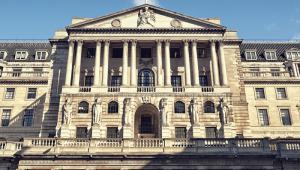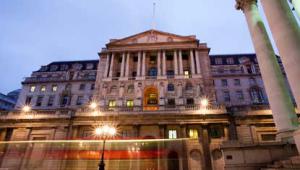13 March 2009
The Bank of England has started printing money in another attempt to revive the economy. In the first of our Budget Watch series, Charles Davis discusses the likely impact of this move and looks forward to the toughest Budget in years
The pace of change in the economy over the past year has been, at times, breathtaking. The UK economy is in a deep recession. In the second quarter of 2008, the economy ground to a halt as lending retrenchment from stricken banks began to take effect. Following this, there were falls in economic output of 0.7% and a staggering 1.5% in the third and fourth quarters of 2008 respectively. This latter contraction was the steepest since 1980. Unemployment has risen to just short of
2 million – and a slow recovery looks set to push it above 3 million, which would be the highest since 1993. As the financial crisis enveloped the UK in 2008, inducing dire outcomes in the real economy, policy responses have had to be significant.
The government has brought two flagship banks under majority public ownership (three, when we consider that Halifax Bank of Scotland and Lloyds TSB were, until recently, two separate institutions). Indeed, International Monetary Fund research has shown that the UK has spent more directly intervening in the financial sector as a share of national output (19.8% in upfront government financing) than any other country in the G20. These interventions make the £20bn fiscal stimulus in the November Pre-Budget Report (around 1.4% of output) seem like small beer. It is in this context that Chancellor Alistair Darling faces one of the most challenging Budgets in years.
On the monetary policy side, the Bank of England has cut the Bank Rate from 5% in September to 0.5% in March, its lowest level in the Bank’s 315-year history. But the monetary policy transmission mechanism is not working as it should: this normally remarkable series of cuts is not giving sufficient stimulus to the economy. Hence, the Bank of England, with the government’s blessing, has embarked upon the abstruse sounding ‘quantitative easing’ in a last desperate throw of the dice to boost the economy.
Just as the interest rate affects the price of money, quantitative easing affects the volume of cash in circulation. It does not suffer from the core limitation of interest rates, which is that they cannot go negative and therefore can only be used up to a point. Therefore, at times when an economy is threatened with deflation and depression, quantitative easing is one of the few options available for monetary easing. How does it work?
The Bank of England has the sole right to create (print) money in the UK. As such, it can create new central bank reserves to finance the purchase of assets from institutions, including banks and governments. This transfers assets on to the central bank’s balance sheet, in turn injecting money into the economy. The chancellor has authorised the Monetary Policy Committee to purchase up to £150bn of assets. In the first instance, the Bank will buy up some £75bn of government debt. The second half of the programme – another £75bn of purchases – could involve up to £50bn of private sector assets.
There should be two main effects from this. First, it will lower borrowing costs as yields fall on the bonds that the Bank purchases. Secondly, banks will have more cash. In normal times, this would translate into more lending. But these are not normal times, so there is a question mark over whether the banks will resume lending. We know that, as part of the ownership arrangements, the government-owned banks will increase lending in 2009. However, the major withdrawal of foreign lenders from the market has undermined lending in the UK while the remaining privately-owned financial institutions might seek to hoard the extra cash to cushion the impact of recession.
There has been some emotive discussion of printing money and hyperinflation in Zimbabwe and 1920s Weimar Germany in the press. However, the circumstances here are quite different: the UK is at risk of a prolonged depression and deflation, which would be potentially disastrous in raising the real value of outstanding debt. So quantitative easing is the right step: but how far to go and when to stop?
With this in mind, the Bank needs to carefully monitor the effect of its actions on corporate and consumer lending. It must ensure that lending (and ultimately the economy) grows in a way consistent with its medium-term 2% inflation target. This must determine when it sells back the assets it purchases to take money out of circulation. The timing is critical – if turning off the tap is delayed, inflation could rocket. But if it is too fast it would likely impair the effectiveness of the intervention. The MPC faces a huge weight of responsibility in this respect – the importance of having transparency and accountability in its actions is paramount.
Quantitative easing has potential implications for Darling and the April Budget. With lower borrowing costs there must be the temptation to engage in a further large fiscal stimulus – especially with an election in mind. While a further stimulus is likely to be necessary – the pre-Budget package is minuscule as a share of output compared with the US and Chinese actions – Darling must seek to remain credible with the markets.
First, he will have to accept a major downgrade in his projections for the economy. In the PBR, Darling assumed that the economy would contract by between 0.75% and 1.25% in 2009. While accepting the reality of recession, the Treasury assumed it would be a short slump that would start to reverse by the second half of 2009. Hence, the economy would return to growth between 1.5% and 2% in 2010.
These assumptions now look a long way off the mark. By the fourth quarter of 2008, economic output had already fallen by 2.2% from its recent peak in the first quarter of 2008. Output in the fourth quarter of 2008 was 1.9% lower than the same period a year earlier. The misguided optimism of this forecast – combined with the ongoing effects of the financial sector interventions – will have profound implications for the position of the public finances.
What will the chancellor forecast now? In our December forecast, the Centre for Economics and Business Research predicted a 2.9% fall in gross domestic product in 2009 as a whole. This would be the worst outcome in a year since demilitarisation following the Second World War in 1946.
Back in December, we were among the most pessimistic of those City and independent forecasting houses published in the Treasury’s monthly forecast comparison. In the latest such poll, however, this view is widely shared. The average of new forecasts in the February publication is for a contraction in economic activity of 2.7% in 2009. Beyond this, economists believe the economy will experience sluggish growth of 0.5% in 2010. There is a concern that the lasting effects of the banking crisis and fiscal retrenchment will retard the recovery in the coming years. So, Darling will have to revise down both the 2009 and 2010 numbers significantly if he is to look credible.
What can he do policy-wise? He will be aware that the fiscal stimulus announced in November is small change compared with US President Barack Obama’s, for example. David Blanchflower of the MPC has pointed out that a stimulus equivalent to the US package would be worth some £90bn. Darling might opt to bring forward more infrastructure projects, especially if they can be brought to fruition relatively quickly. Another temporary tax break could be a possibility – perhaps on lower earners, who have a higher marginal tendency to consume.
While the main issue has to be resolving financial sector issues, expect a further fiscal stimulus to be announced in the Budget. But this will be somewhere short of the £90bn mooted above as Darling is hamstrung by the deteriorating position of the public finances and the need to maintain credibility with investors in UK plc. Official data for January showed that the public sector net borrowing requirement was £67bn in the financial year to date. This compares with net borrowing of just £23bn during the same period in 2007/08. The chancellor forecast overall borrowing of £78bn for 2008/09, but this looks in doubt.
At the CEBR, we think it will likely be stretched closer to £90bn. Beyond this, we expect net borrowing to remain above £100bn in each of the next five years. Hamstrung indeed.
Moreover, the effects of a banking crisis on the real economy are invariably deep and long-lasting. A detailed study of banking crises across around 20 countries has suggested substantial falls in output, employment and a variety of asset prices are to be expected – all of which we are seeing. But the study, by US researchers Kenneth Rogoff and Carmen Reinhert, also suggests that public sector debt explodes in the aftermath of a crisis.
The effects are less to do with the headline-grabbing bank recapitalisations and more to do with the crippling effects of a collapse in tax revenues. Indeed, corporation tax receipts fell by 23% in January 2009 compared with a year earlier. On average, Rogoff and Reinhert found the real value of government debt tends to rise by 86% in the aftermath of a crisis. And the current financial crisis is worse than any since the Great Depression. The PBR forecast that public debt would peak at 57% of gross domestic product. This could well be dwarfed.
So where does this leave us? As public sector debt balloons through the next two to three years, ultimately some tough decisions will have to be made. While the April Budget will likely include a further fiscal stimulus, Darling will need to commit to future fiscal discipline to maintain credibility. This means spending freezes or cuts and tax hikes in the medium term. We are left with an almighty hangover from the ‘end of boom and bust’.



















